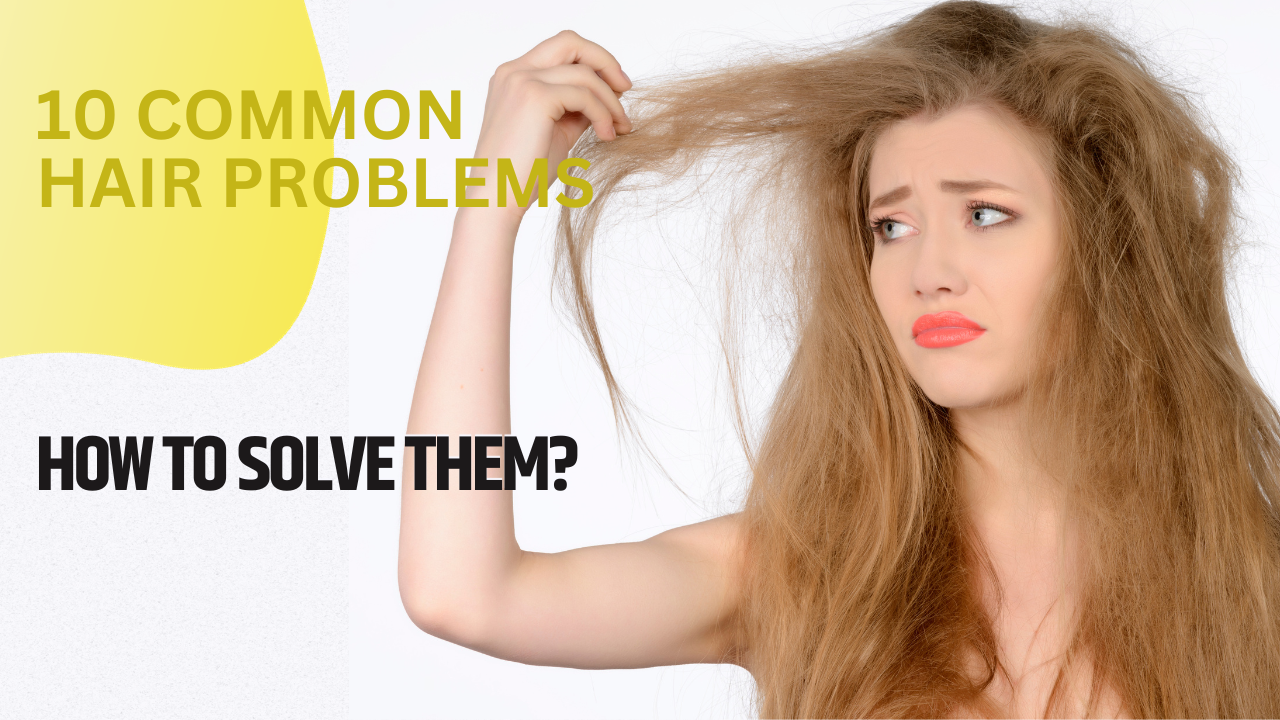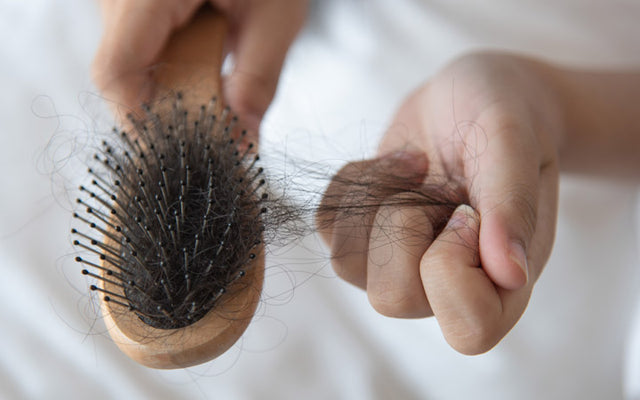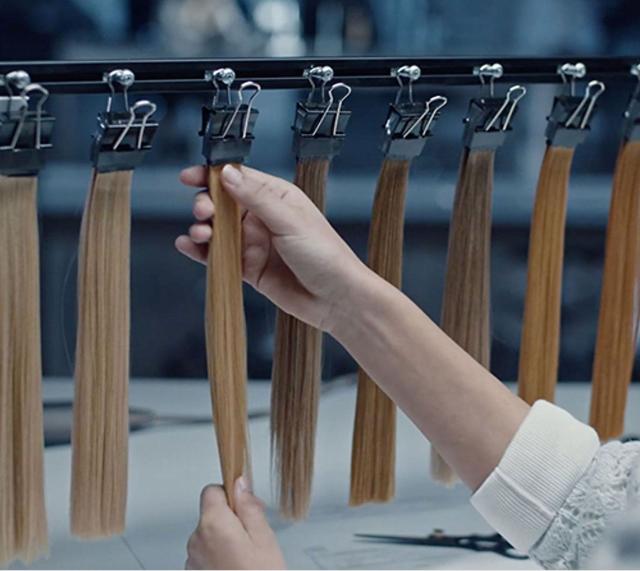Are you struggling with common hair problems? Here are ten solutions to fix them.
Reduce stress levels, use gentle hair products, and lead a healthy lifestyle to improve the condition of your hair. Dry or brittle hair, thinning hair, shedding, tangles, and dullness are signs of hair damage. Some common hair disorders include androgenetic alopecia, alopecia areata, and hair shaft breakage.
Excessive heat and styling can cause split ends, which can be prevented by gently brushing and avoiding towel-drying. Other common hair problems include gray hair, damaged hair, greasy hair, and hair loss. Balancing your doshas and using appropriate hair care products can address these hair concerns. Providing solutions to dryness, frizz, and split ends can also improve the overall health of your hair. Avoid damage from hair coloring by using color-safe shampoos and conditioners.
Understanding Hair Problems
Learn how to fix common hair problems with these ten simple solutions. Whether it’s hair loss, split ends, or an oily scalp, reduce stress levels, use gentle hair products, and maintain a healthy lifestyle to keep your hair looking and feeling its best.
Signs Of Hair Damage
Whether you have straight hair, wavy hair, or curly hair, there are a few clear signs of hair damage that you should be aware of:
- Dry or brittle hair: It is a sign of damage if your hair feels dry or brittle to the touch. This can be caused by excessive heat styling or using harsh hair products.
- Hair Feels Thick at the Root and Thin at the Ends: If you notice that your hair appears thicker at the root and thinner at the ends, it could be a sign of damage. This is commonly seen in hair that is overprocessed or has split ends.
- You Notice More Shedding: Excessive hair shedding can signify hair damage. It may be time to address the underlying issue if you notice more hair strands on your brush or in the shower drain.
- Your Hair Is More Tangled Than Usual: If your hair is becoming tangled quickly and is difficult to detangle, it could be a sign of damage. Damaged hair tends to have roughed-up cuticles, which leads to more tangles and knots.
- Your Hair Appears Dull: It is a sign of damage if your hair lacks shine and appears dull. This can be caused by various factors, including using too many styling products or not correctly nourishing your hair.
Common Hair Disorders
Some of the most common hair disorders that people experience include the following:
- Androgenetic Alopecia: This is a hereditary condition that causes gradual hair thinning and can lead to baldness in both men and women.
- Alopecia Areata: This condition causes sudden hair loss in round patches on the scalp or other body parts.
- Traction Alopecia: Traction alopecia occurs when hair is pulled tightly, leading to hair loss. This is often caused by wearing tight hairstyles such as braids or ponytails.
- Telogen Effluvium: Telogen effluvium is a temporary hair loss condition usually caused by stress, illness, or hormonal imbalances.
- Anagen Effluvium: Anagen effluvium is a condition where hair loss occurs during the growth phase of the hair cycle. This is commonly caused by chemotherapy or radiation therapy.
- Hair Shaft Breakage: Hair shaft breakage refers to breaking hair strands due to various factors such as over-processing, excessive heat styling, or using harsh hair products.
Most Common Hair Damage
The most common type of hair damage is split ends, which occur when the protective outermost layer of the hair (the cuticle) is damaged and peels back. Excessive styling and heat are significant contributors to split ends. To prevent split ends, it is essential to:
- Brush gently. Use a soft, flexible hairbrush and avoid overbrushing to minimize damage.
- Avoid towel-drying: Instead of rubbing your hair vigorously with a towel, gently squeeze out excess water and let your hair air dry, or use a microfiber towel.
- Trim regularly: Regular trims are essential to remove split ends and keep your hair healthy.
By understanding the signs of hair damage, common hair disorders, and the most common hair damage, you can take the necessary steps to address and fix these hair problems. Remember to prioritize gentle hair care practices, minimize heat styling, and nourish your hair with a healthy diet and proper hydration.

Common Hair Problems
Regarding hair problems, we’ve all experienced our fair share of frustrations. From dandruff to split ends, these common issues can wreak havoc on our locks and leave us less confident. But fear not, because in this article, we’ll delve into 10 of the most common hair problems and how you can fix them.
Dandruff
Dandruff is a common condition that causes flaky skin on the scalp. It can be caused by various factors, including dry skin, sensitivity to hair products, and even certain medical conditions. To combat dandruff, use an anti-dandruff shampoo containing zinc pyrithione or ketoconazole. These ingredients can help to reduce the production of excess skin cells on the scalp and alleviate the symptoms of dandruff.
Hair Loss
Hair loss is a common concern for both men and women. Several factors, including genetics, hormonal imbalances, and poor hair care practices, can cause it. To address hair loss, try incorporating a balanced diet of vitamins and minerals, such as biotin and iron, essential for healthy hair growth. Additionally, you can use topical treatments or consult a healthcare professional to explore other treatment options.
Dry Hair
A lack of moisture can cause dry hair and leave your hair feeling rough and brittle. To combat dryness, use a moisturizing shampoo and conditioner specifically formulated for dry hair. You can also incorporate hair masks or oils into your hair care routine to help restore moisture and nourish your hair from root to tip.
Oily Scalp
Having an oily scalp can be frustrating, making your hair look greasy and weighed down. To combat an oily scalp, use a clarifying shampoo to remove excess oil and buildup. Avoid overwashing your hair, as this can strip away the natural oils and cause your scalp to produce even more oil. It’s also important to avoid using heavy hair products that can weigh your hair down and contribute to excess oil production.
Split Ends
Split ends are a common problem when the hair shaft’s protective outer layer is damaged. To prevent split ends, avoid excessive heat styling and opt for heat-protectant sprays when using hot tools. Regular trims are essential to remove split ends and prevent them from traveling up the hair shaft.
Frizz And Flyaways
Frizz and flyaways can be a constant battle, especially in humid weather. To combat frizz, use a smoothing shampoo and conditioner that helps control frizz and provide moisture to your hair. Incorporating a leave-in conditioner or serum into your routine can help ease frizz and smooth and polish your hair.
Dull Hair
If your hair appears dull and lackluster, it may be a sign of damage or a lack of nutrients. To restore shine to your hair, incorporate a clarifying shampoo into your routine to remove buildup and restore vibrancy. You can also consider including a hair gloss or shine serum to add a boost of shine to your locks.
Heat-damaged hair
Excessive heat styling can cause damage to your hair, leaving it dry, brittle, and prone to breakage. To repair damaged hair, it’s essential to give your hair a break from heat styling tools and allow it to air dry whenever possible. Incorporating deep conditioning treatments and using heat-protectant products can also help to repair and protect your hair from further damage.
Hair Color Damage
Color-treated hair can become damaged and lose its vibrancy over time. Use color-safe shampoos and conditioners specifically formulated to protect and preserve color to maintain healthy and vibrant hair color. It’s also essential to avoid excessive heat styling and protect your hair from UV rays by wearing a hat or using a UV-protectant hair product.
You can achieve healthier, more manageable hair by addressing these common hair problems and implementing these tips. Remember, consistency is critical, and with a little extra TLC and the proper hair care routine, you can say goodbye to those hair woes and hello to locks that look and feel their best!
Solving Common Hair Problems
Discover practical solutions to 10 common hair problems, including split ends, an oily scalp, and hair loss. From reducing stress to using gentle hair products and maintaining a healthy lifestyle, learn how to fix and prevent these issues for healthier and happier hair.
Causes And Treatments For Each Hair Problem
Dandruff
Dandruff is a common hair problem caused by an overgrowth of yeast on the scalp. Other factors, such as dry skin, an oily scalp, or sensitivity to hair products, can also contribute to this issue. To treat dandruff, use an anti-dandruff shampoo containing zinc pyrithione or ketoconazole.
Hair Loss
Hair loss can occur for various reasons, including genetics, hormonal imbalances, nutritional deficiencies, and stress. Treatments for hair loss include medications like minoxidil, laser therapy, PRP (Platelet-Rich Plasma) therapy, and hair transplant surgery.
Dry Hair
Dry hair is caused by a lack of moisture in the hair shaft. To fix this problem, use hydrating hair masks or deep conditioning treatments regularly. Avoid over-shampooing and using hot tools frequently, as they can further strip the hair of natural oils.
Oily Scalp
An oily scalp is usually the result of overactive sebaceous glands producing excess sebum. To regulate sebum production, gently clarifying shampoo removes buildup without stripping the scalp. Avoid using heavy hair products that can weigh down the hair and lead to greasiness.
Split Ends
Split ends when the hair shaft becomes damaged and splits into two or more strands. Trim your hair regularly to prevent split ends. Use a leave-in conditioner, oil, or serum to moisturize the hair and temporarily seal the split ends.
Preventive Measures And Home Remedies
Dandruff
To prevent dandruff, maintain a healthy scalp by washing your hair regularly and avoiding excessive use of hair products. Incorporate antifungal ingredients like tea tree oil or apple cider vinegar into your hair care routine. Practice stress management techniques, as stress can worsen dandruff.
Hair Loss
To prevent hair loss, maintain a balanced diet rich in vitamins and minerals. Avoid tight hairstyles that pull on the hair, and minimize the use of heat styling tools. Massage your scalp regularly to improve blood circulation and promote hair growth.
Dry Hair
Prevent dry hair by using a moisturizing shampoo and conditioner. Limit heat styling tools and protect your hair from the sun and harsh environmental conditions. Apply a leave-in conditioner or hair oil to add moisture and prevent dryness.
Oily Scalp
Prevent an oily scalp by washing your hair regularly with a gentle shampoo. Avoid over-brushing your hair, as it can stimulate the sebaceous glands. Use dry shampoo between washes to absorb excess oil and maintain a fresh scalp.
Split Ends
To prevent split ends, avoid excessive heat styling and over-brushing. Use a wide-toothed comb or a brush with natural bristles to detangle your hair. Trim your hair every 4–6 weeks to remove split ends and maintain the overall health of your hair.


Frequently Asked Questions For 10 Common Hair Problems And How To Fix Them
How Do You Fix Common Hair Problems?
To fix common hair problems, reduce stress, use gentle hair products, hydrate, eat a healthy diet, and lead a healthier lifestyle, Signs of hair damage include dryness, brittleness, shedding, tangling, and dullness. Some common hair disorders include alopecia, hair shaft breakage, and hair loss.
Excessive styling and heat can cause split ends, so be gentle when brushing and avoid towel-drying. Other common concerns include gray hair, an oily scalp, frizz, and heat damage. Maintain hair health by using appropriate hair care products.
How Do You Figure Out What’s Wrong With My Hair?
To determine what’s wrong with your hair, look for signs of damage like dryness, brittleness, shedding, tangles, and dullness. Common hair problems include androgenetic alopecia, alopecia areata, traction alopecia, telogen effluvium, and hair shaft breakage. Avoid split ends by gentle brushing, avoiding over-brushing, and towel-drying.
Maintain a healthy lifestyle, reduce stress, and use gentle hair products to prevent hair problems.
What Are The 5 Common Hair Diseases?
The five common hair diseases are Androgenetic Alopecia, Alopecia Areata, Traction Alopecia, Telogen Effluvium, and Anagen Effluvium.
What Is The Most Common Hair Damage?
Excessive styling and heat can cause the most common hair damage: split ends. This occurs when the outer layer of hair is damaged, causing it to peel back. To prevent split ends, brush gently, avoid overbrushing, and towel dry. Using a soft hairbrush and gentle hair products can also help.
Conclusion
In this blog post, we’ve covered ten common hair problems and provided practical solutions. By reducing stress levels, using gentle hair products, staying hydrated, and adopting a healthy lifestyle, you can tackle these issues on your own.
Remember to listen to your hair’s needs and address any signs of damage early on. With these tips, you can say goodbye to dryness, split ends, and other hair concerns. Take charge of your hair health and enjoy beautiful, lustrous locks.
DIY hair oils are some of the most important ingredients to have in your beauty arsenal. They add shine, manage frizzy hair, and help improve your hair health.